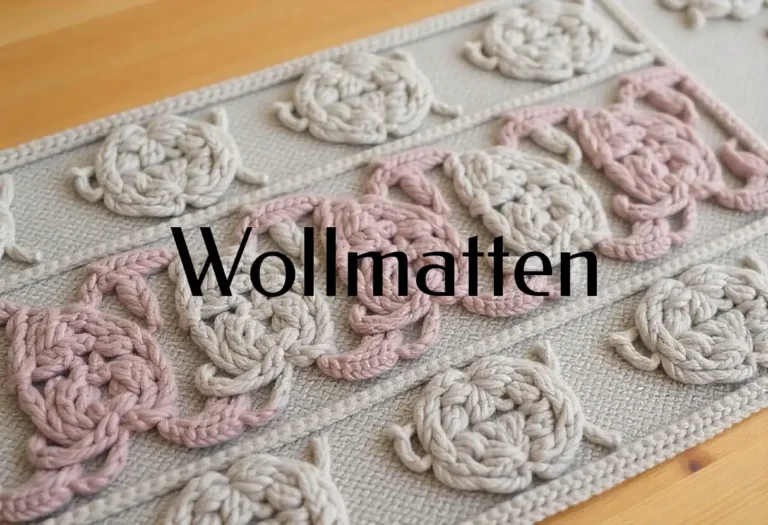You’re standing in your garden, watching weeds take over your vegetable beds. Or maybe you’re looking at your cold living room floor, wondering how to add natural warmth. Wollmatten might be exactly what you need.
These versatile wool mats have been used for centuries across Europe and Asia. Today, they’re experiencing a resurgence as more people seek sustainable, natural solutions for their homes and gardens.
This article covers everything about wollmatten: what they are, how they work, their multiple applications, care instructions, and buying tips. You’ll discover why these simple wool products have become essential for gardeners, homeowners, and eco-conscious consumers worldwide.
Featured Snippet: Wollmatten (German for “wool mats”) are natural mats crafted from sheep wool fibers. They serve multiple purposes including garden mulch, home insulation, floor coverings, and crafting tools. These biodegradable mats retain moisture, suppress weeds, provide thermal insulation, and release nutrients as they decompose over 2-4 years.
What Are Wollmatten?
Wollmatten translates directly from German as “wool mats.” These products are made from natural wool fibers that are pressed, woven, or felted into durable sheets. The wool typically comes from sheep, though some versions use alpaca or goat wool.
The production process involves three main steps. First, wool is sourced from farms, often using fibers unsuitable for clothing production. Second, the raw wool is cleaned and carded to align the fibers. Third, manufacturers either needle-felt, press, or weave the wool into mat form.
Wollmatten vary in thickness, density, and texture depending on their intended use. Thin, breathable versions work well for gardening applications. Thicker, denser mats excel at insulation and soundproofing. Decorative versions serve as rugs or wall hangings in homes.
The beauty of wollmatten lies in their versatility. A single material can adapt to dozens of different applications while maintaining natural, sustainable properties.
Garden and Agricultural Applications
Garden wool mats can store up to 33% of their weight in water, slowly releasing it back into soil to keep plants hydrated. This makes them exceptional mulch alternatives that reduce irrigation needs while protecting plant roots.
Weed control ranks among the top benefits for gardeners. The dense wool mat blocks sunlight from reaching soil, preventing weed germination without chemical herbicides. The density of raw wool makes it an effective weed barrier that provides long-lasting weed control.
These mats release nitrogen, phosphorus, and potassium as they decompose, optimizing plant growth. This natural fertilization happens gradually over time, providing steady nutrition to your plants. The decomposition takes 2-4 years depending on soil contact and environmental conditions.
Pest management offers another practical advantage. Wool fibers have microscopic scales that appear barbed to slugs and snails, creating a natural deterrent. You can protect vulnerable plants without harmful chemicals or expensive barriers.
Gardeners report using wollmatten around tree bases, in vegetable beds, and as winter protection for sensitive plants. Wool keeps soil cool in summer and warm in fall, extending your growing season.
Home and Interior Uses
Wool mats transform cold, hard floors into comfortable living spaces. The natural insulation properties keep feet warm during winter months while adding aesthetic appeal to any room. You can find wollmatten in living rooms, bedrooms, entryways, and home offices.
The thermal regulation works both ways. Wool naturally maintains comfortable temperatures by trapping warm air in winter and staying cool in summer. This property made wool mats essential in medieval European castles and Scandinavian homes for centuries.
Sound absorption provides an often-overlooked benefit. Dense wool mats reduce noise transmission between floors, making them ideal for apartments, music studios, or busy households. The natural fibers absorb sound waves without requiring synthetic materials.
Wool is naturally moisture-resistant and can wick away spills without compromising structural integrity. This makes wollmatten practical for high-traffic areas where accidents happen frequently. The natural lanolin in wool also discourages dust mites, benefiting allergy sufferers.
Interior designers appreciate the natural texture and warmth wool brings to modern spaces. The mats come in various colors, patterns, and sizes to match different aesthetic preferences.
Crafting and Specialized Applications
Quilters and sewers have embraced wool pressing mats as essential tools. These mats offer double-sided pressing because wool retains heat, allowing seams to be pressed from both sides simultaneously. The dense felt keeps fabric in place without slipping, creating perfectly flat seams.
Typical sizes include 17×24 inches for home sewing tables, with compact travel versions available for workshops and classes. The mats need minimal maintenance beyond spot-cleaning with mild soap and air-drying flat.
Wellness practitioners use thin wollmatten for yoga and meditation. The natural cushioning provides comfort during floor exercises while the breathable material prevents overheating. Some practitioners value the grounding properties of natural fibers for mindfulness practices.
Farmers occasionally use wollmatten as livestock bedding. The mats provide warmth, comfort, and moisture absorption superior to synthetic alternatives. This creates healthier environments for animals while utilizing recycled wool that might otherwise be discarded.
Artists and textile designers experiment with smaller wool mats as creative canvases. The flexible, natural surface accepts various techniques including felting, embroidery, and experimental textile work.
Environmental and Sustainability Benefits
Comparison Table: Wollmatten vs. Synthetic Alternatives
| Feature | Wollmatten | Plastic Mulch | Synthetic Rugs |
|---|---|---|---|
| Biodegradable | Yes (2-4 years) | No | No |
| Water Retention | 33% of weight | None | Minimal |
| Nutrient Release | Yes | No | No |
| Carbon Footprint | Low | High | High |
| Renewable | Yes | No | No |
| End-of-Life | Composts naturally | Landfill waste | Landfill waste |
Wollmatten are biodegradable, renewable, and often made from otherwise discarded wool. This circular approach reduces textile waste while creating valuable products. Many manufacturers specifically use wool unsuitable for clothing production, giving new purpose to agricultural byproducts.
The production process requires minimal energy compared to synthetic alternatives. Wool naturally grows on sheep without petroleum inputs or complex chemical processing. Manufacturing involves three simple steps: shearing, cleaning, and processing into fleece mats with minimal energy use.
Wool fibers sequester carbon during growth, similar to how trees remove CO2 from the atmosphere. When the mat eventually decomposes, it enriches soil rather than polluting landfills. This complete lifecycle aligns perfectly with regenerative agriculture and permaculture principles.
The water retention capability reduces irrigation needs by 30-50% in some applications. This conserves precious water resources while supporting healthier plant growth. In drought-prone regions, this benefit becomes increasingly valuable.
How to Choose the Right Wollmatten
Consider your primary purpose before purchasing. Garden applications require thicker mats (10mm) with weather-resistant properties. Home rugs need aesthetic appeal alongside durability. Crafting tools prioritize density and heat retention over appearance.
Thickness determines functionality. Thin mats (5mm) work well for light mulching and plant protection. Medium thickness (10mm) suits heavy-duty garden applications and basic insulation. Thick mats (15mm+) excel at soundproofing and cushioning.
Check the wool source and processing method. Organic, ethically-sourced wool ensures quality and supports sustainable farming practices. Look for products specifying the wool origin and production standards.
Size matters for efficiency. Measure your intended area carefully before ordering. Many suppliers offer custom sizes or mat rolls that you can cut to fit specific spaces. Pre-cut discs work well for individual plants or trees.
Price ranges vary significantly based on quality and application. Garden mats typically cost $15-40 per square meter. Home rugs range from $50-200 depending on size and craftsmanship. Pressing mats for crafters run $30-80 for standard sizes.
Care and Maintenance Guide
Wollmatten require minimal maintenance but benefit from proper care. Garden mats need no special attention since they’re designed to decompose naturally. Simply place them around plants and let nature take its course.
Home rugs and floor mats need regular vacuuming to remove surface dirt and dust. Vacuum at least weekly, especially in high-traffic areas, to prevent dirt from weakening wool fibers. Use gentle suction to avoid pulling fibers from the mat.
For spills and stains, act quickly. Blot liquids immediately with a clean cloth, then use mild detergent and warm water to gently clean the area. Never rub stains, as this pushes them deeper into fibers. Test cleaning solutions on hidden areas first.
Deep cleaning should happen professionally every 12-18 months for home rugs. Professional cleaners recommend warm water extraction processes every two years using wool shampoo to dissolve dirt while removing excess moisture. This extends the mat’s lifespan significantly.
Pressing mats for crafts need different care. Remove loose threads with a lint roller after each use. Store flat to prevent warping or distortion. Spot-clean with appropriate tools designed for felt, and avoid machine washing unless specifically permitted.
Rotate home rugs quarterly to ensure even wear patterns. This simple step prevents certain areas from degrading faster than others. Keep wool mats away from excessive moisture and direct heat sources.
Common Challenges and Solutions
Shedding concerns many new wool mat owners. Hand-knotted and tufted wool products naturally shed because they’re created from long fiber strands, with loose fibers eventually working to the surface. This process decreases over time and doesn’t indicate poor quality.
Moth protection requires attention in humid climates. Store long-term unused mats with cedar blocks or natural moth repellents. Keep wool in dry, cool environments and check regularly for damage signs. Natural lanolin in wool provides some inherent moth resistance.
Initial odor sometimes occurs with new wool products. The natural smell dissipates within days of airing. Place new mats outside on sunny days or in well-ventilated areas to accelerate the process.
Color fading happens gradually with sun exposure. Position valuable decorative pieces away from direct sunlight, or rotate them periodically to maintain even appearance. Garden mats naturally weather and fade as part of their decomposition cycle.
Future Trends and Innovations
Manufacturers are developing blended wollmatten combining wool with other natural fibers like hemp or cotton. These hybrids aim to enhance specific properties while maintaining environmental benefits. Pre-fertilized garden mats with embedded nutrients represent another emerging product line.
Smart wool mats incorporating moisture sensors might soon help gardeners monitor soil conditions remotely. While still in development, these products could improve water management and plant health monitoring.
The strong wool industry continues exploring value-added applications. Companies provide commercial solutions for sectors including landscaping, agriculture, packaging, and insulation. This diversification supports wool producers while meeting market demand for sustainable materials.
Designer collaborations are bringing artistic elements to functional wollmatten. Artisan-crafted versions feature unique patterns, natural dyes, and traditional techniques that appeal to premium markets. These products celebrate wool’s cultural heritage while meeting modern aesthetic standards.
Frequently Asked Questions
How long do wollmatten last in the garden?
Garden wool mats typically last 2-4 years depending on soil contact, moisture levels, and mat thickness. They gradually decompose while releasing nutrients.
Can I wash wollmatten in a washing machine?
Some home rugs allow machine washing on wool cycles with cold water. Always check manufacturer instructions first, as many require hand washing or professional cleaning only.
Do wollmatten attract pests?
Wool naturally deters slugs and snails due to its fibrous texture. Moths may affect stored mats, but proper storage with cedar blocks prevents problems.
Are wollmatten safe for pets and children?
Yes, natural wool mats are non-toxic and safe for families. They contain no harmful chemicals and many people choose them specifically for allergy-friendly homes.
Where can I buy quality wollmatten?
Specialized garden centers, eco-friendly home stores, and online retailers sell wollmatten. Look for products specifying wool source, thickness, and intended application for best results.
Final Thoughts
Wollmatten represent a perfect intersection of tradition, practicality, and environmental responsibility. These simple wool products solve real problems across multiple domains without requiring complex technology or synthetic materials.
Whether you’re mulching tomatoes, warming your bedroom floor, or pressing quilt seams, wollmatten deliver reliable performance with minimal environmental impact. The initial investment pays dividends through reduced water use, eliminated chemical needs, and years of functional service. As more people prioritize sustainable living, these versatile wool mats will continue gaining recognition as intelligent solutions for modern challenges rooted in ancient wisdom.




